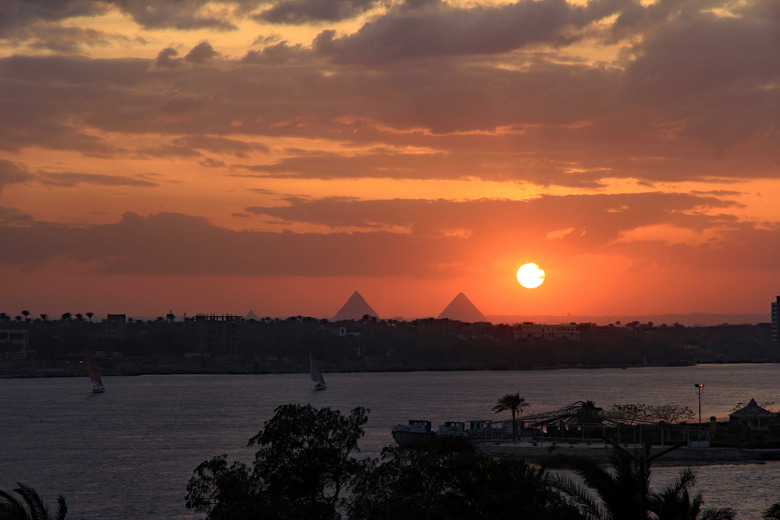Facts About The Ancient Egyptian Nile Delta Area
The Nile Delta area known in antiquity was a vital element of the development of ancient Egyptian society and played an intrinsic part in their religion, culture and day-to-day sustenance. In addition to providing fertile farmland, the Delta offered the ancient Egyptians many other valuable resources.
Geography
Geography
Deltas are characterized by a triangular plain formed where the mouth of the river empties into a larger body of water. The sediment carried by the river's current from the Ethiopian headwaters, where the Nile originates, are deposited on the Delta, which allowed the ancient Egyptians to practice agriculture on a nutrient-rich and productive farmland. Marshes comprised areas of the Delta not covered by silt, clay or harder deposits.
Distributaries
Distributaries
The Nile River in ancient times emptied into the Mediterranean through several distributaries, which helped deposit the river's sediment over a broad area, allowing the ancient Egyptians to farm. The ancient Greek historian Herodotus recorded seven main distributaries around 484 to 424 B.C. The distributary branches in order from east to west were the Pleusiac, Tanitic, Mendesian, Phatmetic, Sebennitic, Bolbitic and Canopic. The network of these branches along the Delta area was tangled and prone to change, and ancient map sources record anywhere from three to 16 main distributaries.
Flora and Fauna
Flora and Fauna
The Nile Delta area in ancient Egypt provided habitat for many types of plant and animal life, some that no longer dwell there. Larger animals such as hippopotamuses and crocodiles lived in riparian areas and swamps. Fish abounded in the Nile's waters, including Nile perch, tilapia, eels, catfish and even sharks. Soft wood trees such as palm trees and sycamores grew along the water's edge, while reeds and papyrus grew in swampier Delta regions. Much of the flora and fauna of the ancient Nile Delta disappeared as Egyptians used the area for increasingly heavy agriculture and domestication.
Ancient Egyptian Uses
Ancient Egyptian Uses
The Nile Delta's features translated into many invaluable uses as a source of hunting, fishing and fertile land for crops. The clay deposited by the Nile over the centuries was used as a raw material for pottery. Most of the major Egyptian cities existed in close proximity to one of the major distributaries of the Delta, including Alexandria and Hermopolis. Cities in the Delta served as ports for river traffic from Upper Egypt as well as markets for traders entering ancient Egypt from the Mediterranean.
Cite This Article
MLA
Sanders, DaVaun. "Facts About The Ancient Egyptian Nile Delta Area" sciencing.com, https://www.sciencing.com/ancient-egyptian-nile-delta-area-10267/. 9 March 2018.
APA
Sanders, DaVaun. (2018, March 9). Facts About The Ancient Egyptian Nile Delta Area. sciencing.com. Retrieved from https://www.sciencing.com/ancient-egyptian-nile-delta-area-10267/
Chicago
Sanders, DaVaun. Facts About The Ancient Egyptian Nile Delta Area last modified March 24, 2022. https://www.sciencing.com/ancient-egyptian-nile-delta-area-10267/
